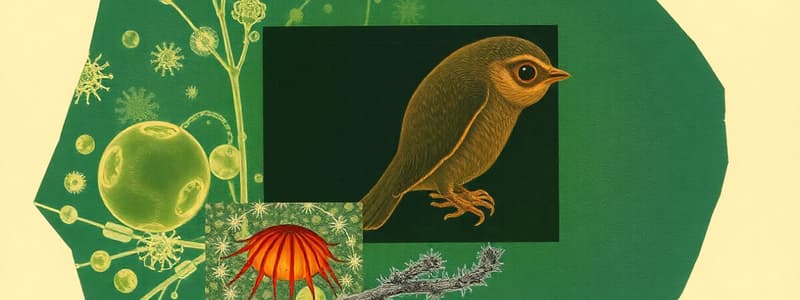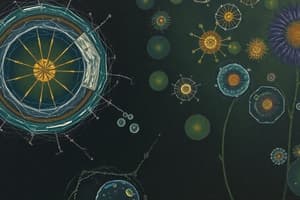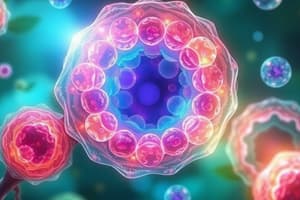Podcast
Questions and Answers
Which of the following statements accurately reflects the significance of the cell theory in biological studies?
Which of the following statements accurately reflects the significance of the cell theory in biological studies?
- It suggests that all cells are spontaneously generated from non-living matter.
- It provides a foundational understanding that the functions of living organisms are linked to the activities within their cells. (correct)
- It limits the study of life to only single-celled organisms, disregarding multicellular life forms.
- It primarily focuses on classifying different types of cells based on their size and shape.
How did the invention of the light microscope change the understanding of living things?
How did the invention of the light microscope change the understanding of living things?
- It hindered scientific advancements because the images produced were blurry and unclear.
- It confirmed the long-held belief that living things were made of continuous material.
- It shifted the focus of biological studies to molecular biology, bypassing the study of cells.
- It allowed scientists to see cells for the first time, leading to the development of the cell theory. (correct)
Before the 1600s, what belief about the structure of living things was most common?
Before the 1600s, what belief about the structure of living things was most common?
- Living things were made of a combination of cells and non-cellular materials.
- Living things did not have a physical structure.
- Living things were made of continuous, undivided material. (correct)
- Living things were composed of individual, discrete cells.
In the context of cell theory, what does the principle 'all cells come from pre-existing cells' primarily refute?
In the context of cell theory, what does the principle 'all cells come from pre-existing cells' primarily refute?
Which of the following best characterizes Robert Hooke's contribution to the development of cell theory?
Which of the following best characterizes Robert Hooke's contribution to the development of cell theory?
A plant cell is placed in a hypotonic solution. Which cell structure primarily prevents it from bursting due to the increased turgor pressure?
A plant cell is placed in a hypotonic solution. Which cell structure primarily prevents it from bursting due to the increased turgor pressure?
Which organelle is responsible for modifying, sorting, and packaging proteins and lipids in both plant and animal cells?
Which organelle is responsible for modifying, sorting, and packaging proteins and lipids in both plant and animal cells?
During cell division in plant cells, what is the primary role of the Golgi bodies?
During cell division in plant cells, what is the primary role of the Golgi bodies?
If a cell lacked ribosomes, what process would be immediately affected?
If a cell lacked ribosomes, what process would be immediately affected?
Which of the following statements accurately describes a key difference between vacuoles in plant and animal cells?
Which of the following statements accurately describes a key difference between vacuoles in plant and animal cells?
A cell is found to have a high concentration of digestive enzymes. Which organelle is likely abundant in this cell?
A cell is found to have a high concentration of digestive enzymes. Which organelle is likely abundant in this cell?
A scientist is studying a cell and observes that it has a rectangular shape and a cell wall. Which type of cell is the scientist most likely observing?
A scientist is studying a cell and observes that it has a rectangular shape and a cell wall. Which type of cell is the scientist most likely observing?
If a cell is exposed to a toxin that disrupts the function of mitochondria, which of the following processes would be most directly affected?
If a cell is exposed to a toxin that disrupts the function of mitochondria, which of the following processes would be most directly affected?
Which of the following cellular structures is NOT directly involved in movement?
Which of the following cellular structures is NOT directly involved in movement?
During which phase of the cell cycle does the cell actively synthesize new proteins and grow?
During which phase of the cell cycle does the cell actively synthesize new proteins and grow?
A mutation occurs in a gene responsible for producing a critical enzyme. Which outcome is LEAST likely?
A mutation occurs in a gene responsible for producing a critical enzyme. Which outcome is LEAST likely?
Which of the following represents the correct base pairing in DNA?
Which of the following represents the correct base pairing in DNA?
What is the primary function of cell checkpoints in the cell cycle?
What is the primary function of cell checkpoints in the cell cycle?
How does cytokinesis differ between animal and plant cells?
How does cytokinesis differ between animal and plant cells?
A karyotype reveals that a child has three copies of chromosome 21. This condition is known as:
A karyotype reveals that a child has three copies of chromosome 21. This condition is known as:
Which of the following describes the relationship between chromatin, chromosomes, and chromatids?
Which of the following describes the relationship between chromatin, chromosomes, and chromatids?
Flashcards
Cell Theory: 1st Point
Cell Theory: 1st Point
All living things are composed of one or more cells.
Cell Theory: 2nd Point
Cell Theory: 2nd Point
The cell is the basic organizational unit of life; understanding cells is key to understanding life.
Cell Theory: 3rd Point
Cell Theory: 3rd Point
All cells arise from existing cells; spontaneous generation does not occur.
Microscope's Role
Microscope's Role
Signup and view all the flashcards
Pre-Microscope Beliefs
Pre-Microscope Beliefs
Signup and view all the flashcards
Cell Wall Function
Cell Wall Function
Signup and view all the flashcards
Chloroplast Function
Chloroplast Function
Signup and view all the flashcards
Cell Membrane Function
Cell Membrane Function
Signup and view all the flashcards
Cytoplasm
Cytoplasm
Signup and view all the flashcards
Endoplasmic Reticulum Function
Endoplasmic Reticulum Function
Signup and view all the flashcards
Nucleus Function
Nucleus Function
Signup and view all the flashcards
Ribosomes Function
Ribosomes Function
Signup and view all the flashcards
Lysosomes Function
Lysosomes Function
Signup and view all the flashcards
Nucleolus
Nucleolus
Signup and view all the flashcards
Nuclear Membrane
Nuclear Membrane
Signup and view all the flashcards
Cell Wall
Cell Wall
Signup and view all the flashcards
Cilia
Cilia
Signup and view all the flashcards
Flagellum
Flagellum
Signup and view all the flashcards
Chloroplast
Chloroplast
Signup and view all the flashcards
Chromosomes
Chromosomes
Signup and view all the flashcards
Mutation
Mutation
Signup and view all the flashcards
Study Notes
Cell Theory
- All living organisms consist of one or more cells
- The cell is the basic organizational unit of life, understanding cell function is understanding life
- All cells arise from pre-existing cells, refuting spontaneous generation
History of Cell Knowledge
- Before the 1600s, living things were thought to be made of continuous material
- In 1665, Robert Hooke observed "little boxes" in dried cork using a simple microscope
- The modern cell theory developed by the late 1800s
- Knowledge of cells grew with microscopy advancements
Animal vs Plant Cells
- Plant cells contain cell walls for support, protection, and shape, preventing bursting from increased turgor pressure, animal cells forgo this need with only a cell membrane
- Plant cells have large vacuoles for retaining water and pushing the nucleus; animal cells have smaller vacuoles
- Chloroplasts are present in plant cells for photosynthesis but absent in animal cells
- Plant cells have many Golgi bodies (hundreds) for cell wall assembly, animal cells have very few
Organelles and Their Functions
- Cell membrane controls movement in and out of the cell
- Cytoplasm consists of watery material containing substances involved in cell metabolism
- The endoplasmic reticulum transports materials, involved in synthesis and storage
- The nucleus serves as the control center for cell metabolism and reproduction
- Ribosomes act as sites of protein synthesis
- Lysosomes digest food within the cell
- Mitochondria serves as the powerhouse of the cell
- The Golgi apparatus serves as a storage center for secretory products
- Centrosomes, in animal cells, are involved in cell division
- Vacuoles are fluid-filled organelles that store food or wastes
- Nucleolus for ribosome production
- The nuclear membrane controls movement in and out of the nucleus
- Cell walls give cells shape and provide protection, only present in plant cells
- Cilia & Flagellum are hair-like structures used for movement
- Chloroplasts are the site of photosynthesis
- During cytokinesis, the new cell plate forms on both sides
- Chromosomes carry genetic information
Importance of microscopes
- Microscopes are relevant because...
DNA and Chromosomes
- DNA's molecular structure includes bases, sugar, and phosphate
- Chromosomes are rod-shaped, condense, and carry genetic information
The Need for Cell Division
- Cell checkpoints ensure proper cell division
- Cancer is linked to cell division malfunction
Cytokinesis
- During cytokinesis, new cell plates form on both sides of plant cells
- During cytokinesis, actin filaments constrict forming a cleavage furrow
Cell Mutations
- 3 #21 chromosomes indicates Down's Syndrome, totaling 47 chromosomes in the Down's example
Studying That Suits You
Use AI to generate personalized quizzes and flashcards to suit your learning preferences.
Related Documents
Description
Overview of cell theory, its historical development, and comparison between plant and animal cells. Includes cell structure, function, and differences in organelles like vacuoles and chloroplasts. Covers the roles of cell walls and turgor pressure.




